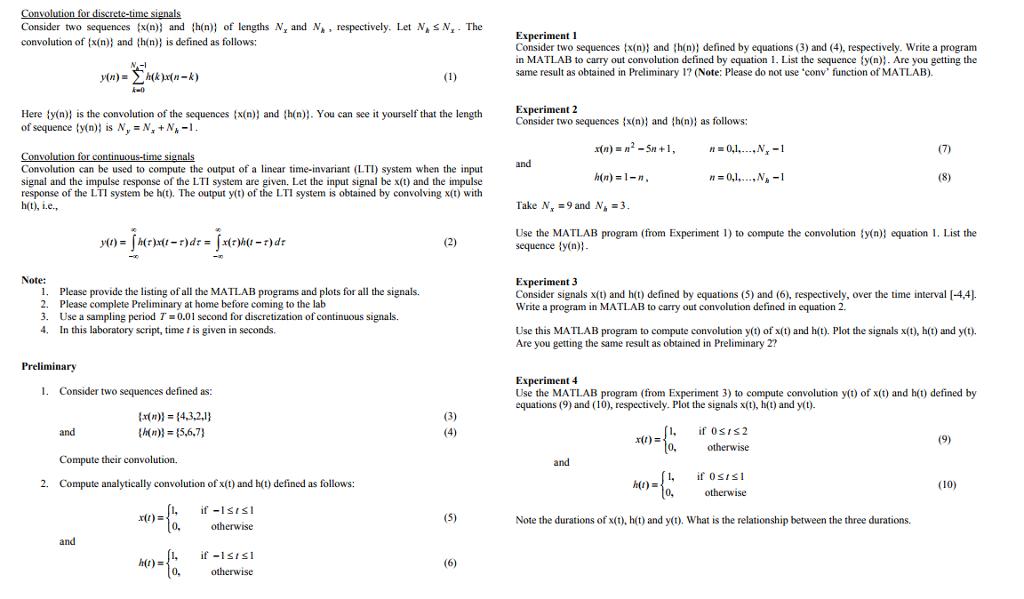Convolution for discrete-time signals Consider two sequences (x(n)} and (h(n)} of lengths N, and N,, respectively. Let N, s N,. The convolution of (x(n)}

Convolution for discrete-time signals Consider two sequences (x(n)} and (h(n)} of lengths N, and N,, respectively. Let N, s N,. The convolution of (x(n)} and th(n)} is defined as follows: Experiment 1 Consider two sequences {x(n); and (h(n); defined by equations (3) and (4), respectively. Write a program in MATLAB to carry out convolution defined by equation 1. List the sequence fy(n)}. Are you getting the same result as obtained in Preliminary 1? (Note: Please do not use "conv function of MATLAB). (1) Here {y(n)} is the convolution of the sequences (x(n)) and (h(n)}. You can see it yourself that the length of sequence ty(n); is N, = N, + N, -1. Experiment 2 Consider two sequences (x(n)} and (h(n)} as follows: x(n) = n? - Sn +1, n= 0,1...N, -1 (7) Convolution for continuous-time signals Convolution can be used to compute the output of a linear time-invariant (LTI) system when the input signal and the impulse response of the LTI system are given. Let the input signal be x(t) and the impulse response of the LTI system be h(t). The output y(t) of the LTI system is obtained by convolving x(t) with h(t), i.e., and h(n) = 1-n, n = 0,1,.,N, -1 (8) Take N, =9 and N, = 3. Use the MATLAB program (from Experiment 1) to compute the convolution {y(n)} equation 1. List the sequence (y(n)}- (2) Note: Please provide the listing of all the MATLAB programs and plots for all the signals. Please complete Preliminary at home before coming to the lab 2. 3. Use a sampling period T=0.01 second for discretization of continuous signals. In this laboratory script, time i is given in seconds. Experiment 3 Consider signals x(t) and h(t) defined by equations (5) and (6), respectively, over the time interval [-4,4]. Write a program in MATLAB to carry out convolution defined in equation 2. 1. 4. Use this MATLAB program to compute convolution y(t) of x(t) and h(t). Plot the signals x(t), h(t) and y(t). Are you getting the same result as obtained in Preliminary 2? Preliminary Experiment 4 Use the MATLAB program (from Experiment 3) to compute convolution y(t) of x(t) and h(t) defined by equations (9) and (10), respectively. Plot the signals x(t), h(1) and y(t). 1. Consider two sequences defined as: {x(n)} = (4,3,2,1} {n)) = [5,6,7) (3) and (4) if osis2 (9) o, otherwise Compute their convolution. and if osisi 2. Compute analytically convolution of x(t) and h(t) defined as follows: h(1) = (10) otherwise if -1sisI x(1) = (5) Note the durations of x(t), h(t) and y(t). What is the relationship between the three durations. otherwise and if -1sis1 h(t)= 10. (6) otherwise
Step by Step Solution
3.47 Rating (163 Votes )
There are 3 Steps involved in it
Step: 1
Convolution output below 3 The given funchon alt and h H exists in between 1 and I ht t Over the ...
See step-by-step solutions with expert insights and AI powered tools for academic success
Step: 2

Step: 3

Ace Your Homework with AI
Get the answers you need in no time with our AI-driven, step-by-step assistance
Get Started


